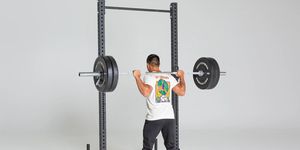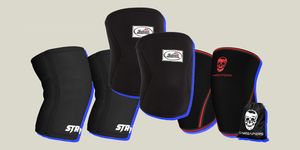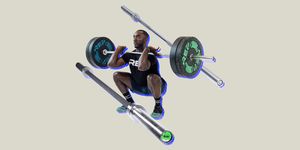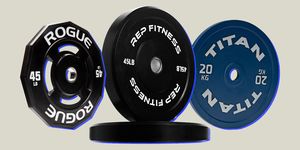We all have that one exercise that, when it comes up in our training programs, sparks groans of disgust and hesitancy. It could be a modality that you’re struggling to progress with, like a bench press that’s just not ready for an added plate. It could be a tiresome, grueling movement that leaves you gassed at set’s end, like walking lunges. More often than not, however, the exercise of agony is ... the back squat.
Squats, especially barbell squats, can be the thorn in many a lifter’s side for a number of reasons. It’s one of the most complicated, difficult movements you’re likely to perform in a strength training workout, yet the rewards are too bountiful to ignore.
Having had my own bouts with this boogeyman, I’ve developed a few habits to ensure that squats and myself stay on speaking terms. When approaching the rack, it’s all about being prepared, prioritizing safety and knowing failure will occur on occasion … and that’s not a bad thing.
Why Are Barbell Squats So Intimidating?
For one thing, the notion that the weight is resting on your sensitive spine is enough to strike fear in anyone that’s dealt with lower-back issues. Sure, you can drop the weight if things go awry, but unlike with, say, a deadlift, the weight is traveling from such a high elevation. Getting out of the way, especially when squatting in a proper rack, can require heightened focus and attention.
Additionally, squats are intimidating because they’re just plain difficult. There’s a lot of moving parts to the movement — from your legs, to your back, core and hips. Few exercises are as taxing on the full body. Think about it: where are you likely to push yourself further — a bench press or a squat? Both place heavy weight over your frame in less than ideal locations, but the fact that you’re less likely to fatigue yourself entirely during a heavy bench press can be enough motivation to go for a little higher total.
Are Barbell Squats Truly Safe?
If there’s so much hesitation surrounding the barbell squat, is the risk truly worth the reward? Well, yes … if you do it right. As stated before, the barbell squat employs a number of different muscle groups at once, and the weight is held along your spine. So it’s imperative to know exactly how to perform the exercise, as well as how much resistance you should be working with on a given day. Once you understand how to squat and how much weight to lift, your opportunity for in-gym progress is unmatched.
Outside of form, you also have your equipment and training partner to rely on. Having a knowledgeable spotter at the ready can really help you get through a squat set without any issues. Additionally, the racks and equipment of today feature a number of safety mechanisms, all designed to help you stay in control and avoid injury.
Squatting properly comes down to respecting the exercise itself and employing the right tactics. Follow these tips to stay safe and get strong.
4 Safety Tips for Proper Barbell Squats
1. Warm up for better mobility
Squats require a lot of hip mobility to reach proper depth and keep your form intact throughout. Going in cold can leave you lifting less weight than desired and limit your range of motion to the point that you’re not reaping the proper results.
Ensure your hips are firing and flexible by employing some stretches before getting under the bar. Monster walks, frog stretches and other resistance band exercises can be great for getting these joints in motion.
I also recommend warming up your legs with a brief cardio session on the treadmill or elliptical. It'll get some blood circulating to the muscles being worked, and the pace doesn’t need to be too aggressive — walking is just fine. Finally, some deep breath work can activate your core and get your lungs pumped up for battling through the weight.
2. Set safety mechanisms before even touching the weight
Before you get into squatting for reps, you want to make sure that your equipment is ready to perform if your sets don’t go as planned. Many of the best squat and power racks are compatible with a slew of safety mechanisms, including spotter arms, pins and straps. Take a few reps of just the barbell by squatting to your desired depth and seeing where your safeties should rest. You want them to catch the barbell as quickly as possible, so placing them one notch or pin below your depth should suffice.
As for which safety mechanism to choose, straps can absorb the shock and impact of a dropped barbell more gently and can be less of a detriment to your barbell in the process. It is best, though, to match your safety equipment to your rack, if you do need to purchase it separately. Below are a few options compatible with one of our favorite racks for squats, the Titan Fitness T-3 Series.
You'll also want to consult with your spotter, if working out with an associate, indicating to them when you'd like assistance during your lift and where you think your sticking points will be.
3. Pair good form to a good weightlifting belt
Having your form set in stone is another key component to keeping your squat workout as danger-free as possible. Rest the barbell along your back with your shoulder blades pushed back, opening your chest. Keep your feet shoulder width apart and grab the bar with a wide grip to ensure more stability and control. Keeping your back straight and eyes up, begin your descent by pushing your butt back while hinging at the hips, almost as if you’re sitting down in a chair. Bend at the knees and slowly control the bar down to your crouched position. Once you’ve reached parallel (thighs parallel to the floor) or your intended depth, push through your heels and return to your standing position, keeping your back straight and chest open throughout the movement.
To help keep your core engaged and back braced properly throughout the movement, you can also employ a weightlifting belt. Used properly, weightlifting belts can help create a sturdier trunk and allow you to focus on moving the weight more. Below are a few belts I really like. For more, check out our guide to the best weightlifting belts.
4. Know when and how to bail
Even if you do everything right, sometimes the weight is too much to handle. Maybe you’re more tired than perceived. Maybe you’re coming back from an injury, or worn down from previous sets. Whatever the case, knowing when and how to bail is key to keep this minor failure from turning into a major setback.
First, a bailed squat should occur toward the bottom of your movement. This keeps the distance the barbell has to travel to the safeties at a minimum, giving less room for injury and equipment damage. Conveniently, that's also where you’re likely to find your sticking point — where the resistance is too much to overcome and movement back toward the top position stalls out.
To bail out of a back squat, you should slowly lower your positioning to where the barbell nearly touches the safeties. Then, bring your chest forward and let the weight roll off your back. The safeties will stop the weight from crashing to the floor. If you’re lifting outside of the rack without any safeties, you’ll want to lunge or shuffle yourself forward as the weight moves in the opposite direction.
Front squats are a little easier to ditch, since you’re essentially dropping the weight in front of you and can see its trajectory more clearly. When you release the barbell, throw your elbows back to get your arms out of the way, all while shuffling yourself backward to avoid any potential harm. Again, do so as close to the safeties as possible to help preserve your rack and barbell — and, of course, yourself.






























